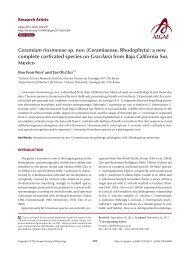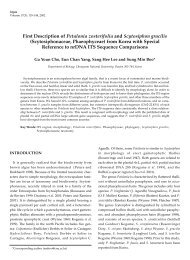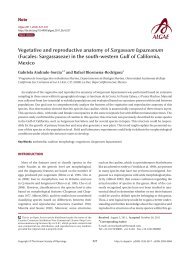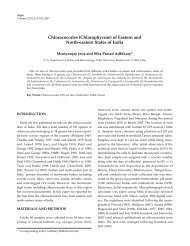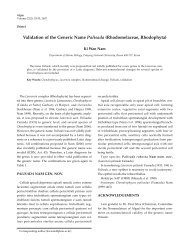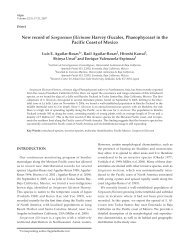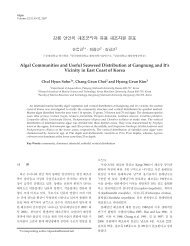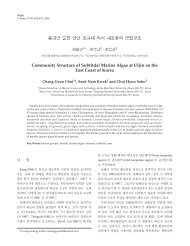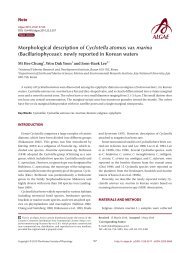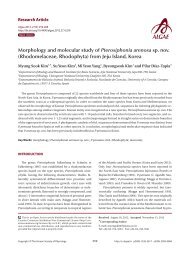New Records of Marine Algae from Korea I
New Records of Marine Algae from Korea I
New Records of Marine Algae from Korea I
You also want an ePaper? Increase the reach of your titles
YUMPU automatically turns print PDFs into web optimized ePapers that Google loves.
150 <strong>Algae</strong> Vol. 17(3), 2002<br />
cells cut <strong>of</strong>f lateral initials towards the surface and<br />
branched several times to form cortex. Cortical layer was<br />
1-3 cells thick and cortical cells were subspherical to<br />
polygonal in surface, 8-12 µm in diameter (Fig. 3D).<br />
Subcortical cells were subspherical to stellate with elongated<br />
arms, 13-18 µm in diameter. Medulla has a few<br />
slender filaments (rhizoids), which were transeversely<br />
located. The rhizoids arose <strong>from</strong> the inner subcortical<br />
cells to grow transversely out <strong>of</strong> the medulla. They were<br />
usually unbranched and consisted <strong>of</strong> 3-5 elongated cells,<br />
55-150 µm long and 4-5 µm broad (Fig. 3E).<br />
Tetrasporophytes were 15-20 cm long and 13-15 cm<br />
broad (Fig. 3A). Tetrasporangia were scattered over the<br />
frond and globular in surface (Fig. 3G), elliptic in cross<br />
section (Fig. 3F). They were zonately divided, 28-34 µm<br />
long and 18-22 µm broad (Fig. 3H). Carposporophytes<br />
were 10-15 cm long and 10 cm broad (Fig. 3B).<br />
Carpogonial branches consisted <strong>of</strong> 3-4 cells were borne<br />
<strong>from</strong> subcortical cells (Fig. 4A). Intercalary cells <strong>of</strong> them<br />
were usually distended to one side. After fertilization,<br />
the carpogonium and the intercalary cells divided transversely<br />
into two derivative cells (Fig. 4C). The carpogonial<br />
derivative cells produced 1-2 connecting filaments.<br />
The second connecting filament was cut <strong>of</strong>f <strong>from</strong> each<br />
derivative cell opposite to the first (Fig. 4C). The connecting<br />
filaments were septate and branched. Auxiliary<br />
cells arisen <strong>from</strong> the subcortical cells produced 3-4 lateral<br />
branches with small cortical cells. They were round to<br />
broadly obovate, 20-28 µm long and 13-20 µm broad<br />
(Fig. 4B). After fusion between the connecting filament<br />
and the auxiliary cell, the auxiliary cell initiated a hemispherical<br />
lobe that developed gonimoblast initial (Fig.<br />
4D-E). The gonimoblast initials were divided and developed<br />
into gonimoblasts (Fig. 4F). The gonimoblasts grew<br />
inwards in the thallus. Cystocarps were globular, 200-<br />
350 µm in diameter and densely scattered over the whole<br />
frond and immersed under the cortical layer (Fig. 4G).<br />
Spermatangia were not found.<br />
Plants adrift were collected <strong>from</strong> the beaches <strong>of</strong> the<br />
eastern and the southern coasts. Most <strong>of</strong> them were<br />
found at the sheltered area with sandy and rocky substrata.<br />
Matured plants attached to pebbles <strong>of</strong>tenly<br />
occurred at the shallow tidal pools in lower intertidal<br />
zone.<br />
Halarachnion latissimum was characterized by filmy,<br />
delicate membranous habit and zonately divided<br />
tetrasporangia. These features were similar to<br />
Schizymenia dubyi (Chauvin) J. Agardh commonly<br />
occurred in <strong>Korea</strong>, but H. latissimum showed more mem-<br />
branaceous, rounded to subcordate thallus, and thinner<br />
cortical layers consisted <strong>of</strong> 1-2 cells thick than those <strong>of</strong> S.<br />
dubyi. Additionally, H. latissimum was distinguished<br />
<strong>from</strong> S. dubyi by carposporangia showing inward development.<br />
In this study, it was remarkable to recognise<br />
this species as the first member <strong>of</strong> the family<br />
Furcellariaceae in <strong>Korea</strong>.<br />
At present two more species were known in the genus<br />
Halarachnion: H. ligulatum (Woodward) Kützing and H.<br />
parvum Yamada. H. parvum endemic to Japan showed a<br />
smaller habit with ca. 1 cm in height (Yamada 1941).<br />
Among them H. ligulatum, a subtidal species in the<br />
Atlantic, was similar in simple blade morphology to H.<br />
latissimum. H. ligulatum was distinguished <strong>from</strong> H. latissimum<br />
by occasionally much-divided thallus with very<br />
narrow segments and <strong>of</strong>tenly proliferous branches at the<br />
margins and the surfaces (Knauss and Hommersand<br />
1989). In addition, H. ligulatum was monoecious with<br />
spermatangia and carposporangia on same thallus<br />
(Knauss and Hommersand 1989), whereas spermatangia<br />
were not found on carposporic plants <strong>of</strong> H. latissimum in<br />
present study.<br />
Halarachnion ligulatum showed a heteromorphic life<br />
history in which tetrasporophyte formed discoid crust<br />
corresponding to Cruoria rosea (Crouan frat.) Crouan frat.<br />
(Boillot 1965; Kornmann and Sahling 1977; Maggs 1983).<br />
However, we could collect cystocarpic and tetrasporic<br />
plants with erect and membranaceous habit <strong>of</strong> H. latissimum.<br />
It agreed well with the report that H. latissimum<br />
has an isomorphic life history (Okamura 1933). The discrepancies<br />
in the life history between H. ligulatum and H.<br />
latissimum led to question their relationship and suggested<br />
that two species could be separated at the generic<br />
level. As the genera in the family Furcellariaceae showed<br />
both heteromorphic and isomorphic life history, the further<br />
study needs to confirm their relationships.<br />
REFERENCES<br />
Allender B.M. and Kraft G.T. 1983. The marine algae <strong>of</strong> Lord<br />
Howe Island (<strong>New</strong> South Wales): the Dictyotales and<br />
Cutleriales (Phaeophyta). Brunonia 6: 73-130.<br />
Boillot A. 1965. Sur l’alternance de generations heteromorphes<br />
d’une Rhodophycée, Halarachnion ligulatum (Woodward)<br />
Kützing (Gigartinales, Furcellariacées). C.R. Acad. Sc. Paris<br />
261: 4191-4193.<br />
Dawson E.Y. 1944. The marine algae <strong>of</strong> the Gulf <strong>of</strong> California.<br />
Allan Hancock Pacific Expeditions 3: 189-453, 47 pls.<br />
Falkenberg P. 1879. Die Befruchtigen und die<br />
Generationswechsel von Cutleria. Mitt. Zool. Stat. Neapel 1:



